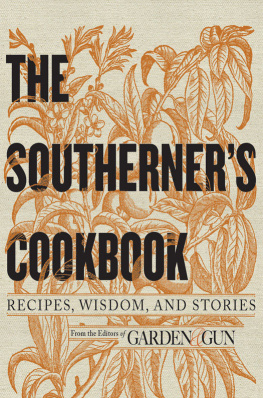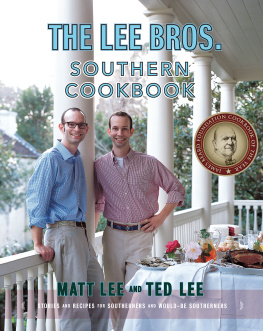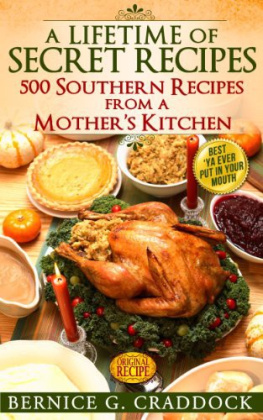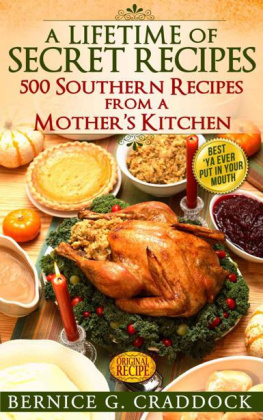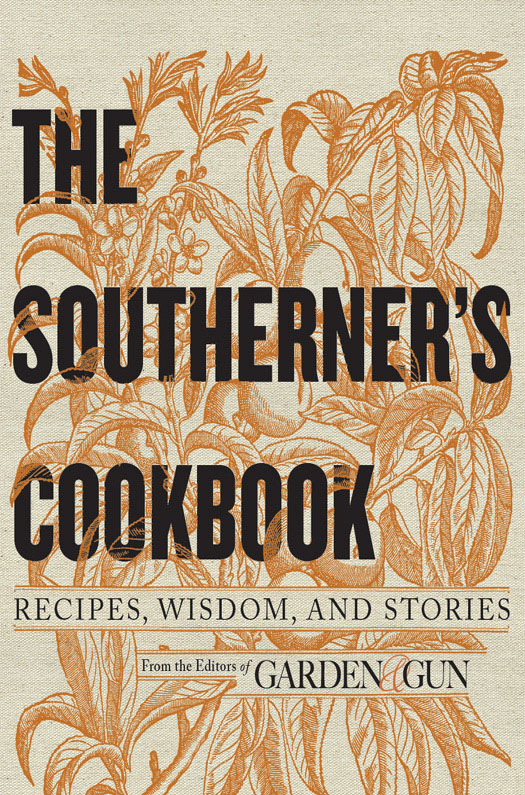
As anyone who grew up on the food can attest, life without a little South in your mouth at least once in a while is a bland and dreary prospect.
JOHN EGERTON


CONTENTS

PARTY BITES & APPETIZERS
CHICKEN
PORK, BEEF, & LAMB
FISH & SHELLFISH
GAME
VEGETABLES & SIDES
BAKED GOODS & DESSERTS
CONDIMENTS, SAUCES, & SPREADS
COCKTAILS
Glossary
Guide


W HEN NOT AT SCHOOL OR PRACTICING SPORTS during my teenage years, I could often be found on a small boat in the coastal waters near my Savannah, Georgia, home. I loved being on the water, but I really loved to fish. My season would usually start in April as the water temperature pushed toward the 70s and fish of all stripes showed up. Whiting, a small bottom-feeding fish, arrived first, and while they didnt necessarily offer much sport, they tasted good. I often pan-fried them for lunch, coated in House Autry seafood breader, and, once on the plate, drenched in vinegar. Refined cooking this was not. But providing a meal and then delivering it to the table brought me a level of satisfaction that I had not yet known. And it was fresh. These were not the fish I would see at the supermarket, their eyes cloudy and skin drained of color, with flesh that would hold the indentation of your finger if you applied pressure. Those fish, I thought, were hardly suitable for bait much less lunch.
And so it is. We Southerners are picky about our ingredients. Almost snooty. Well drive out of the way to get to a farm stand where we know the peaches are ripe and the tomatoes are still warm from the field. Ive witnessed heated debates on the best oyster for a roast: the prevailing opinion in the Lowcountry of South Carolina, where I live now, being Beaufort Clusters. (And how dare you steam them too long!) When the local farmers market gets green peanutsthe best for making boiled goobers, aka boiled peanutsour cell phones buzz with text messages. Theyre here.
Were also attuned to the land around us. When June rolls around youll find me poking around the woods of my hunt club in search of the first chanterelles of the season. I love to saut the fleshy, apricot-scented mushrooms with Vidalia onions in butter and white wine and pair them with homemade pasta. Since they dont freeze well, the surplus gets divvied up in brown paper lunch bags for friends, the foraging equivalent of dropping off a sack of tomatoes from the garden on your neighbors doorstep. In the fall during certain moon tides, the jumbo white shrimp leave the Charleston Harbor en masse before the onset of cold weather. Those willing to brave the cold and backbreaking work cast weighted nets in deep water to intercept them. The payoff is the freshest shrimp youve ever tasted.
But you dont need to live in the South to cook like a Southerner. As the editor in chief of Garden & Gun magazine Im lucky to spend time with chefs who supplied the fuel for the recent rocket-like ascendancy of Southern food to national prominence. And Ive learned that while good ingredients are important, tips and techniques help, too. The farm-to-table movement has taught us much about the pleasures of eating seasonally, but whats left out of the phrase is the cook. Chef Chris Hastings of Birminghams Hot and Hot Fish Club showed me that a dry brine of kosher salt tames the gaminess of a wild turkey breast before you toss it on the grill. And my go-to Thanksgiving dish, a sweet potato casserole, comes courtesy of Chef Tandy Wilson of City House in Nashville, Tennessee. Wilson brilliantly swaps the standard marshmallow topping for a crumbly and very Southern combination of chopped peanuts and sorghum. These are the same chefs we rely on in the pages of the magazine and who helped inform this cookbook. And while every one of them will tell you that theyre riding on the backs of the chefs and home cooks who came before them, theyre also expanding the boundaries of Southern food. It has never been more vibrant.

Hopefully youll find this book is as much a celebration of the Souths foodways as it is a guide to our regions bounty and how to prepare it. The more than one hundred recipes cover a range of Southern traditions, from barbecue to entertaining to our love affair with vegetables and our appreciation of wild game. And, yes, there are a few potent drink recipes, too. (Throwing a bash? Try the Charleston Brown Water Society Punch.) Youll find plenty of classics (fried chicken, country ham with red-eye gravy, biscuits) but also new takes on traditional Southern dishes and ingredients (kilt greens with bacon jam, collard pesto, duck poppers with goat cheese). If you grew up in the South and are familiar with Southern food, I hope it will help expand your repertoire and provide some new favorites. If youre new to Southern cooking, its a great primer to the scope of the regions traditions and why eating here is such a joy. No matter where you live, time at the tablewhether at home, a hunt club, a dinner party, or a church hallhas the power to bring us all together in a sacred and intimate moment.
For the record, I still love to fry fish. But these days I take a cue from Chef Justin Devillier of La Petite Grocery in New Orleans. I no longer rely on House Autry but instead dip fillets of freshly caught sea trout in a mix of three eggs, one cup of milk, and several dashes of hot sauce, dredge them in seasoned cornmeal, pan fry them, then add an over-easy egg atop the fillets. A few more healthy shakes of Crystal hot sauce and a squeeze of lemon replace the vinegar shower of old. Its a simple recipe that lets the fish shine, and it has become my favorite weekend breakfast to share with family and friends. I hope this book inspires lots of new ideas to share with yours.

Critical as they are to some of the best-loved dishes in the Southern canon, bacon and butter are as much at home in Michigan as Mississippi. But when you see White Lily Flour or any of the following ingredients in the pantry or fridge, you know youre in a Southerners kitchen.


